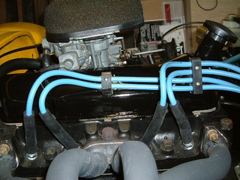David Jenkins
|
| posted on 8/1/07 at 10:53 AM |

|
|
Spark prevention gap
Just for interest's sake - does anyone know how far a plug lead should stand off from an earthed metal surface to avoid problems? I'm
making a couple of plug lead supports out of nylon, so I'll probably end up making it as thick as I can get away with from the material
I've got - but it would be interesting to know what the official recommendation is.
Also, any ideas for keeping holes sealed in a rocker cover? The only way I can see for fixing these supports is by using a small bolt from the
inside, with a big dollop of threadlock on the outside nut to stop the bits falling into the works. Trouble is, I don't want oil seeping out, as
it undoubtedly will if not sealed properly.
I could use double-sided tape, but I'd have to be confident that it would stay on when hot, otherwise my plug leads would fall onto the exhaust
manifold...
cheers,
David
|
|
|
|
|
flak monkey
|
| posted on 8/1/07 at 11:14 AM |

|
|
The pinto plug leads are clipped to the side of the rocker cover. The only issue is if the lead chaffs through, which it shouldnt be in a position to
do anyway. So why worry about it?
Use some closed end pop rivets to attach some cable tie bases to the side of the rocker cover and cable tie the leads to them. The rivets are used for
gas tight containers, so should do the job!
David
[Edited on 8/1/07 by flak monkey]
Sera
http://www.motosera.com
|
|
|
David Jenkins
|
| posted on 8/1/07 at 11:33 AM |

|
|
quote:
Originally posted by flak monkey
So why worry about it?
Not worried! Just curious... 
I don't want to use tie-wraps, as I'd prefer not to destroy a heap of them every time I want to take the plug leads off. I get through of
those things without making it worse! 
cheers,
David
|
|
|
DIY Si
|
| posted on 8/1/07 at 11:38 AM |

|
|
I'm not sure what the gap should be, but on my mini at night you can see all sorts of sparks going off from the leads where they lie against
metal bits. A range of 5mm would be sufficient to prevent any problems. As for sealing, just use normal sealant. It's the only thing stopping
some of my rocker boxes from leaking at all.
“Let your plans be dark and as impenetratable as night, and when you move, fall like a thunderbolt.”
Sun Tzu, The Art of War
My new blog: http://spritecave.blogspot.co.uk/
|
|
|
iank
|
| posted on 8/1/07 at 11:59 AM |

|
|
Not the locost way, but they are cheap to buy, and 'should' be tested to avoid parasitic arcing.
e.g. http://www.rallydesign.co.uk/catalog/index.php?cPath=420_421_547
Shouldn't be too hard to seal as it only has to deal with oil vapour, closed head rivet would be perfect, but a rivnut should also do fine and
would allow you to disassemble the thing if needed.
Make sure any sealant can't fall off into the valvegear!
|
|
|
David Jenkins
|
| posted on 8/1/07 at 12:09 PM |

|
|
That's roughly what I'm planning to make, near enough. I'd thought of buying some, but the minimum postage charge is almost as much
as the parts themselves. Anyway, I'd rather make my own, so that I can make them exactly as I want them!
I've only got open-ended rivnuts - I suppose I could threadlock them to get a seal...
cheers,
David
|
|
|
NS Dev
|
| posted on 9/1/07 at 02:08 PM |

|
|
plug weld brackets onto the rocker cover, assuming its steel.
Retro RWD is the way forward...........automotive fabrication, car restoration, sheetmetal work, engine conversion
retro car restoration and tuning
|
|
|
David Jenkins
|
| posted on 11/1/07 at 04:16 PM |

|
|
This is what I ended up doing - made some nylon spacers, fixed them to metal plates, then used closed-end pop rivets to fix them to the rocker
cover.
Nice & solid, and actually look better in real life than they do in this picture!
Thanks for the ideas - several were incorporated in the final design...
David
 
Rescued attachment DSCF0030.JPG
|
|
|













